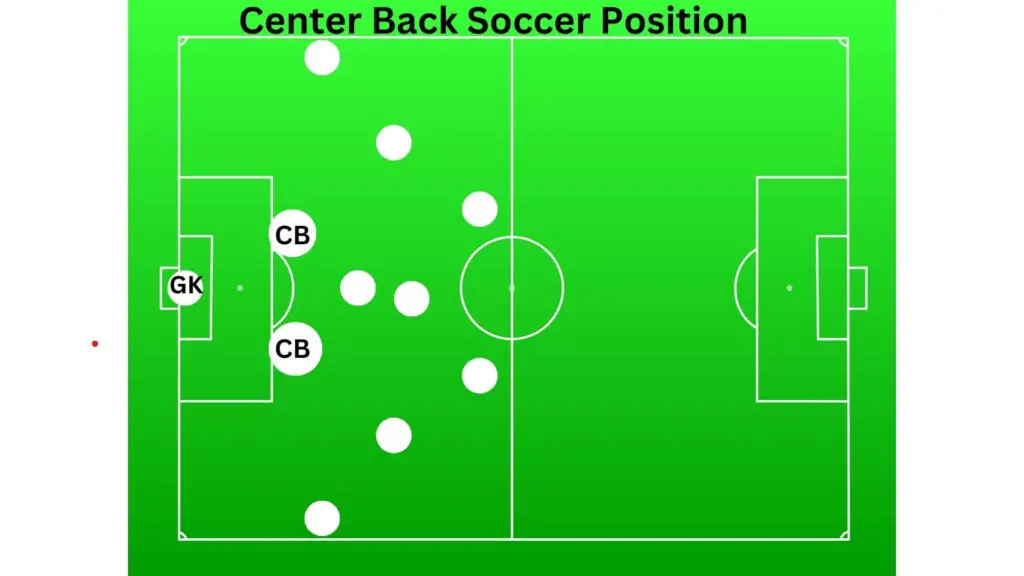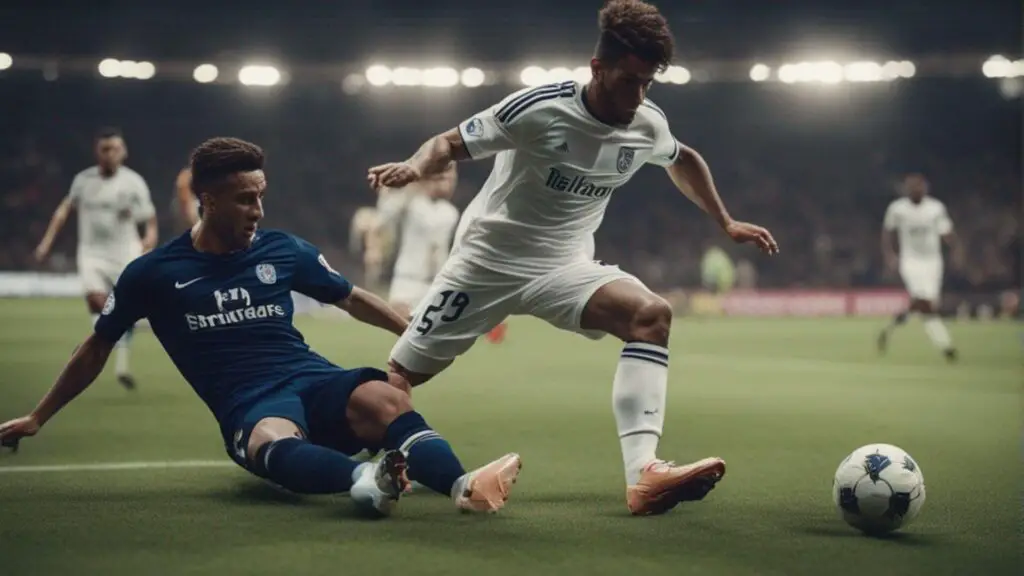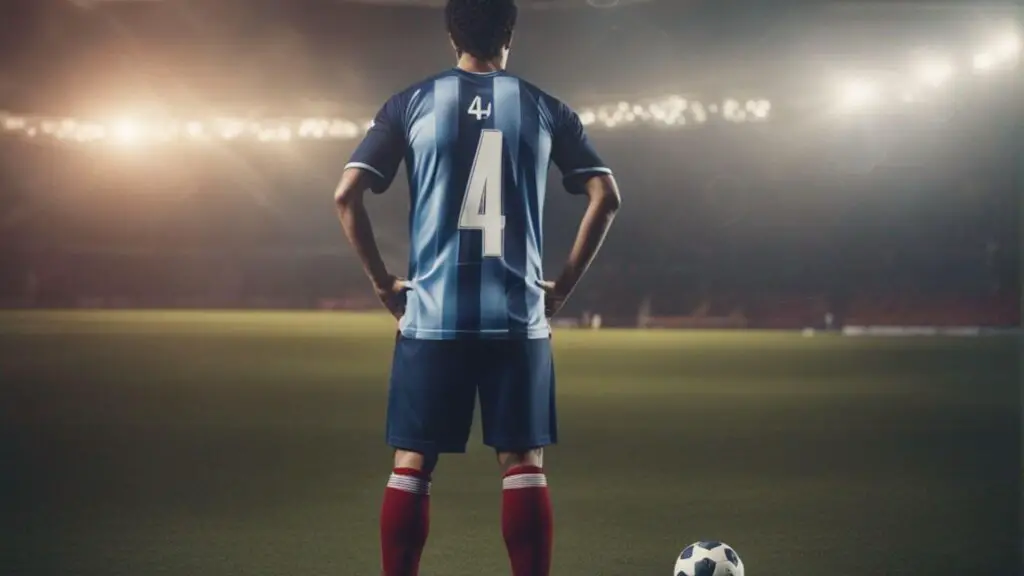While all soccer positions on the field are essential, today we’ll focus on the unsung hero at the heart of every solid defense – the Center Back.
In this post, we’ll explore the role of this critical soccer position, the qualities that make an exceptional Center Back, and how they orchestrate the defensive symphony on the pitch.
Let’s get started.
Table Of Contents
- What is the Center Back in Soccer?
- What does a Center Back Do in Soccer?
- Where does a Center Back Play in Soccer?
-
Is Center Back an important position in soccer?
-
The Core Qualities of a World-Class Center Back
- Centre Back Positioning Tips
- Center Back Soccer Position Number
- Famous Center Back Duos: Partners in Defensive Excellence
-
FAQs: Center Back in Soccer
- 1. How do I become a better center back in soccer?
- 2. Do center backs need to be fast?
- 3. Do center backs score goals?
- 4. Can a center back be strong?
- 5. What is the difference between a full back and a center back?
- 6. What is the difference between a center back and a sweeper?
- 7. Do center backs need to be tall?
- Final Thoughts
What is the Center Back in Soccer?
The Center back in soccer is a defensive position responsible for protecting the goal and thwarting opponents’ attacks. They are the pillars of the defense.
What does a Center Back Do in Soccer?
In soccer, the center back is the defensive stalwart, guarding the goal like a fortress. They thwart opponents’ attacks, execute precise tackles, and use their aerial dominance to win headers. The center back orchestrates the defense, reads the game like a strategist, and initiates attacks from the back with their passing skills.
A crucial position on the pitch, the center back is the team’s shield, combining physicality, mental resilience, and tactical prowess to secure victory.
Where does a Center Back Play in Soccer?

In the beautiful game of soccer, the center back holds court in the heart of the defense, forming a formidable wall just in front of the goalkeeper. This crucial position ensures protection for the goal, standing tall against opposition attacks.
With strategic precision, the center back orchestrates the defense and marshals the backline, making it a pivotal role in the team’s success.
Is Center Back an important position in soccer?
Absolutely! The center back is an important position in soccer. They form the defensive backbone, thwarting attacks, and protecting the goal. A skilled center back can influence the entire game’s outcome!
The center back is a critical position in soccer due to several key reasons:
1. Defensive Leader:
The center back is often the defensive leader on the pitch. They organize the defensive line, communicate with teammates, and provide crucial instructions to maintain a cohesive defense.
2. Goal Protection:
Center backs are the primary barrier between the opposition and the goal. Their timely tackles, interceptions, and blocking skills prevent attackers from scoring.
3. Aerial Dominance:
A significant number of goals in soccer come from aerial situations, such as corners and crosses. Center backs, often tall and strong, excel in winning aerial duels and clearing danger from the box.
4. Game Reading:
Top center backs possess excellent game reading abilities. They anticipate opponents’ moves, track runs, and position themselves strategically to cut off passing lanes and intercept balls.
5. Initiating Attacks:
While their primary focus is defense, modern center backs are also proficient in starting attacking plays from the back. Their accurate passing and ball distribution play a vital role in building attacks.
6. Versatility:
Center backs are versatile players who can adapt to different defensive strategies and formations. They may play as part of a two-center back system or anchor a three-man defense.
7. Covering Teammates:
When full-backs or defensive midfielders venture forward, center backs provide cover and balance to ensure the defense remains secure.
8. One-on-One Duel Mastery:

Center backs often find themselves in one-on-one situations against skilful forwards. Mastering these duels requires composure, timing, and solid defensive technique.
9. Stopping Counterattacks:
Center backs play a crucial role in preventing fast-paced counterattacks by quickly regaining possession and halting the opposition’s forward momentum.
10. Mental Resilience:
The center back position demands mental resilience and composure. They must remain calm under pressure and bounce back from mistakes, inspiring confidence in the entire team.
In summary, the center back position is indispensable in soccer. The defensive prowess, leadership, versatility, and ability to read the game make center backs indispensable assets for any team striving for success on the soccer pitch.
The Core Qualities of a World-Class Center Back
1. Tactical Awareness
A great Center Back reads the game like an insightful chess player, always anticipating the opponent’s moves. They are masters at analyzing the flow of the game, positioning themselves strategically to intercept passes and block shots.
2. Physical Dominance
A towering presence on the pitch, the Center Back must be a commanding figure, dominating aerial duels and showcasing impeccable tackling skills. Their imposing physique strikes fear into the hearts of opposition attackers.
3. Calm Under Pressure
In the high-stakes world of soccer, pressure is omnipresent. The best Center Backs stay cool, calm, and collected even in the face of relentless attacks, acting as pillars of stability for their teammates.
4. Precise Passing
The Center Back is not just a defender; they are the initiator of the team’s attacks. Adept at distributing the ball with laser-like accuracy, they often kickstart offensive manoeuvres from deep within their own half.
Centre Back Positioning Tips
Positioning is a fundamental aspect of a center back’s game, influencing their ability to read the play and thwart attacking threats effectively. Here are some essential positioning tips for center backs:
- Stay Goal-side: Always position yourself between the opponent and the goal. This ensures you have the advantage when contesting for the ball and minimizes the chance of attackers getting behind you.
- Maintain Compactness: Work closely with your defensive partners to maintain a compact defensive shape. This makes it difficult for opponents to find gaps in the defense.
- Cover the Offside Line: Be vigilant about the offside trap. Time your movements carefully to catch opponents offside when the defensive line steps forward.
- Anticipate Opponent Movements: Read the game and anticipate where the opposition is likely to move. This enables you to intercept passes and cut off attacking lanes proactively.
- Use Angles to Your Advantage: Position yourself at angles that allow you to see both the ball and the attacker. This gives you a better view of the play and enables quicker reactions.
- Track Runs Carefully: Keep track of attacking players making runs behind the defensive line. Time your movements to stay with them without leaving gaps for others to exploit.
- Stay on Your Feet: Avoid committing too early to tackles. Stay on your feet as long as possible to retain the ability to adjust your position and prevent attackers from going past you.
- Avoid Ball-Watching: Focus on the attacker’s movements rather than the ball. This prevents you from being deceived by feints or losing track of your defensive responsibilities.
- Balance Aggression with Caution: While being assertive in challenges is essential, avoid being overly aggressive. Mistimed tackles can lead to dangerous situations or conceding free-kicks.
- Communicate Constantly: Effective communication is vital in organizing the defense. Keep your teammates informed about the positioning of opponents and coordinate defensive efforts.
- Shift as a Unit: Move laterally with the defensive line to maintain a cohesive unit. Shifting together minimizes gaps between defenders, making it harder for attackers to exploit spaces.
- Assess and Adjust: Continuously assess the game’s flow and adjust your positioning accordingly. Adapt to changes in the opponent’s tactics and the match’s dynamics.
Center backs can become strong defensive assets by mastering the art of positioning. They can effectively neutralize attackers while maintaining the team’s defensive stability.
Center Back Soccer Position Number

In soccer, the center back is commonly assigned the jersey number 4. The numbering system traditionally follows a specific pattern, with defenders often wearing numbers 2 to 5.
The number 4 jersey is symbolic of the center back’s crucial role in the heart of the defense, acting as the defensive anchor and orchestrating the backline. The number 4 center back embodies qualities like resilience, leadership, and defensive prowess, making it an iconic position in the sport.
While the number 4 jersey is most commonly associated with center backs, some teams may assign other numbers to center backs based on their own squad numbering traditions or the preferences of individual players.
Nevertheless, the number 4 remains synonymous with the position and represents the backbone of any solid defense in the beautiful game of soccer.
==>> Also read: Can soccer players wear the number 0?
Famous Center Back Duos: Partners in Defensive Excellence
Some of the most legendary defensive performances have been courtesy of dynamic Center Back duos. Think of Terry and Carvalho, Nesta and Maldini, or Piqué and Puyol.
These partnerships exemplify the beauty of mutual understanding, synchrony, and trust.
You can also check out Soccer Prime to learn about the best Center backs of all time.
FAQs: Center Back in Soccer
1. How do I become a better center back in soccer?
To become a better center back, focus on defensive fundamentals like positioning, tackling, and aerial ability. Study the game, learn from experienced players, and practice regularly. Work on communication and mental resilience to lead the defense confidently.
2. Do center backs need to be fast?
While speed is beneficial, center backs don’t need to be the fastest players. Agility and quick reactions are more crucial for covering opponents and reacting to attacking threats effectively.
3. Do center backs score goals?
Scoring goals isn’t the primary role of center backs, but they can contribute during set-pieces or when venturing forward. Their main focus is defensive duties and initiating attacks from the back.
4. Can a center back be strong?
Yes, center backs are often solid and physical to handle tough challenges. Strength helps them win aerial duels and hold off opponents in one-on-one situations.
5. What is the difference between a full back and a center back?
Fullbacks play on the flanks and support both defense and attack. Center backs, on the other hand, stay central, concentrating on defensive duties and organizing the backline.
6. What is the difference between a center back and a sweeper?
A center back is a standard defensive player in the heart of the defense. A sweeper, or libero, plays behind the defensive line and acts as the last line of defense, often having a more roaming role.
Read more about the sweeper position here.
7. Do center backs need to be tall?
While height is advantageous for winning aerial duels, center backs can excel with different heights. What matters more is their positioning, timing, and ability to read the game.
Final Thoughts
The Center Back, a defensive general and a key playmaker, holds the fort with unwavering dedication and composure. Their tactical awareness, physical prowess, and leadership qualities make them an indispensable asset for any successful soccer/football team.
As we conclude this deep dive into the world of Center Backs, let us never forget the immense contributions of these unsung heroes. They are the guardians of the goalposts, the sentinels of defense, and the architects of brilliant counterattacks.
The next time you witness a Center Back in action, take a moment to appreciate the dedication and passion that drive these defensive maestros to excel in their art.
You can also read my complete guide about the defense positions in soccer here.

